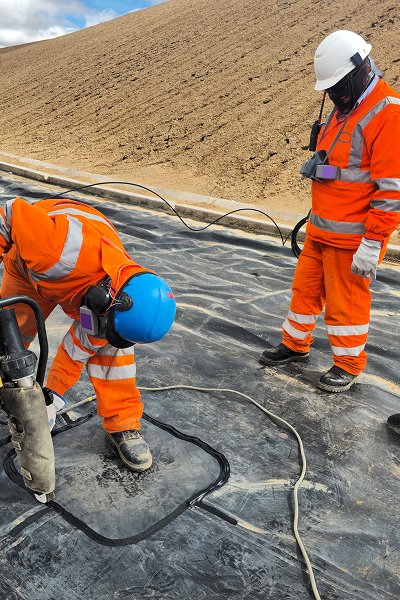The basics of composite geomembrane
Composite geomembrane is a new type of anti-seepage material made by combining high-molecular-weight HDPE geomembrane with non-woven geotextile. Typically constructed as a "one-textile, one-membrane" or "two-textile, one-membrane" system, one or both sides of the geomembrane are tightly bonded to the geotextile through processes such as thermal lamination, gluing, or calendering to form an integrated structure.

Composite Geomembrane Structure
Geomembrane Layer
Common Material: High-Density Polyethylene (HDPE)
Main Function: Provides extremely low permeability, blocking the migration of moisture, gases, and pollutants
Features: Strong chemical stability, acid and alkali resistance, corrosion resistance, and UV resistance
Geotextile Layer
Common Materials: Polypropylene (PP), Polyester (PET) non-woven or woven fabrics
Main Function: Enhances the mechanical strength and tensile strength of the composite membrane, improving puncture resistance and friction coefficient
Features: Good flexibility, stress distribution, and adaptability to uneven settlement
Working Principle of Composite Geomembrane
Impermeability: Geomembrane is impermeable, acting as an anti-seepage barrier.
Reinforcement and Protection: Geotextiles reinforce, cushion, and protect the membrane, reducing the risk of puncture and tearing during construction and operation.
Synergy: The geomembrane and non-woven geotextile combine to form a flexible yet strong structure, resulting in both high impermeability and excellent mechanical properties.

Advantages of Composite Geomembranes
Excellent Seepage Control
The geomembrane layer has a permeability coefficient as low as 10⁻¹³ cm/s, virtually completely blocking liquid and gas permeation.
It prevents seepage losses in reservoirs, canals, and other projects, as well as leachate from landfills and sewage ponds, from contaminating groundwater. Compared to clay layers and concrete linings, it offers a more durable and reliable anti-seepage effect.
High Strength and Deformation Resistance
The geotextile used as a reinforcement layer significantly improves the material's tensile strength, tear strength, and puncture resistance.
It can withstand differential settlement, foundation deformation, or thermal stress without cracking.
Aging and Chemical Resistance
Using high-molecular-weight polymers (such as HDPE and EVA), it offers excellent resistance to UV rays, oxidation, and acid and alkali, maintaining stable performance even under long-term sunlight exposure and chemical corrosion.
The service life is generally 20–30 years, far exceeding that of a single geomembrane or traditional clay anti-seepage layer.
Easy Construction and Highly Adaptable
The finished product can be produced in widths of 4–8 meters, is lightweight, and is easy to transport and install.
The mature construction process allows for either hot-melt welding or extrusion welding, resulting in joint strength that matches or even exceeds that of the parent material.
Applications of Composite Geomembrane
Water Conservancy Projects: Reservoir and dam anti-seepage, channel anti-seepage
Environmental Protection Projects: Landfill base/cover, sewage treatment tanks
Transportation Projects: Tunnel anti-seepage, subway foundation pit retaining wall
Landscape Projects: Artificial lakes, anti-seepage landscape ponds




Composite geomembranes, a new type of anti-seepage material, offer significant advantages in anti-seepage projects, combining the low permeability of geomembranes with the high strength and protective properties of geotextiles. Compared to traditional methods like clay layers and concrete linings, they offer more durable and reliable anti-seepage effects. They also boast high strength, aging resistance, ease of construction, and economical efficiency, maintaining stable performance in complex geological conditions and changing environments.
Composite geomembranes have been widely used in a variety of anti-seepage projects, including water conservancy projects, landfills, artificial lakes, tailings ponds, and tunnels. Their superior overall performance has gradually become the mainstream choice. From the perspective of long-term operation and maintenance, composite geomembranes not only help ensure project safety, but also effectively reduce operating costs and minimize environmental impact.


